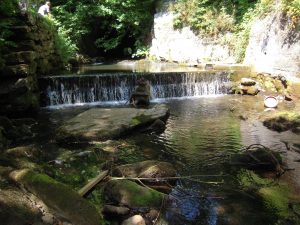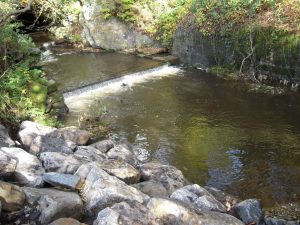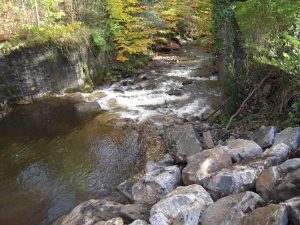- Name of project:
Creating an easement over the old water abstraction weir immediately downstream of the Tunnel at Ynysybwl on the River Clydach, Grid Ref. ST 06058 94259.
- Purpose:
To allow migratory fish to access an additional 4 KM (approx.) upstream of this barrier to reach the spawning gravels and nursery areas of the River Clydach and its tributaries.
- Description of Project:
This Barrier to migratory fish was identified by EAW representatives, during a walk over survey and SEWRT volunteers visited the site during 2009 and again in July 2010.
The barrier comprised a concrete weir approx. 1metre high, across the full width of the weir with a shallow plunge pool (approx. 0.4 metres deep) downstream, necessitating the migrating fish to jump the 1 metre approx. to overcome the barrier, which could not be achieved in all but high river flows.
Various options were considered and eventually it was agreed that the best option would be, to build a pre-barrage type boulder weir downstream of the existing weir, to effectively raise the level of water in the existing plunge pool, thereby reducing the height of jump necessary to approx. 0.3 metres. which was considered acceptable.
Various contractors were approached to carry out this work and eventually Spencers ECA Ltd. And Mr. Damian Mc. Carthey were selected and engaged to carry out the work.
Establishing land ownerships for permission to access the site to carry out this work proved very difficult. However, with the help of the EAW we managed to identify all the landowners concerned and eventually obtain the necessary written permissions.
Construction of the Pre-Barrage type weir commenced on Monday 11th October 2010 and was completed the following day, which also included some bank stabilization and reinforcement work on the R.H. bank downstream of the weir.

- Photographs were taken before any corrective action work had been carried out, which clearly showed the extent of the barrier problem and also on completion of the easement, which, clearly demonstrated that the barrier was no longer an issue.


- The effectiveness of eliminating this barrier to fish migration will be monitored during 2011-12 for reports of migratory fish passing over this easement and by the analysis of future EAW electro-fishing surveys, which, hopefully, will indicate the presence of migratory fish Fry and Parr upstream of this location.
- Funding for this project was provided by EAW.